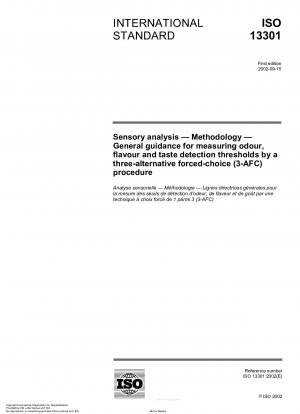ISO 13301:2002
Sensory analysis - Methodology - General guidance for measuring odour, flavour and taste detection thresholds by a three-alternative forced-choice (3-AFC) procedure
- Standard No.
- ISO 13301:2002
- Release Date
- 2002
- Published By
- International Organization for Standardization (ISO)
- Status
- Replace By
- ISO 13301:2018
- Latest
- ISO 13301:2018
- Scope
- This International Standard provides guidance on: — obtaining data on the detection of chemical stimuli that evoke responses to odour, flavour and taste by a 3-AFC (three-alternative forced-choice) procedure; — the processing of the data to estimate the value of a threshold and its error bounds, and other statistics related to the detection of the stimulus. Typically, the procedures will be used in one of the following two modes: — investigation of the sensitivity of assessors to specific stimuli; — investigation of the ability of a chemical substance to stimulate the chemoreceptive senses. (Although experiments may encompass both modes.) Examples of the first mode would include studies of the differences among individuals or specified populations of individuals in sensitivities and of the effects of age, gender, physiological condition, disease, administration of drugs and ambient conditions on sensitivity. Examples of the latter mode would include: — studies in flavour chemistry and the impact of specified chemicals on the flavour of foods; — classification of chemicals for their impact on humans, if present in the environment; — studies on the relationship of molecular structure to capacity of a chemical to act as a stimulant; — quality assurance of gaseous effluents and of water, foods and beverages; — studies in the mechanism of olfaction. In both modes the way in which probability of a correct response changes with intensity of stimulus, i.e. the slope of the dose/response curve, could be an important aspect of the study as well as the threshold value, and the data processing procedures described here provide this information. The focus of this International Standard is on data requirements and on computational procedures. Regarding the validity of the data, the text is restricted to general rules and precautions. It does not differentiate between detection and difference thresholds; fundamentally, the procedures measure a difference threshold because a test sample is compared with a reference sample. Typically, the reference sample is not intended to contain the stimulus under investigation, but the Guidelines do not exclude experimental design in which the reference could contain the stimulus, or it might not be known if the reference contains the stimulus. The Guidelines do not measure a recognition threshold as defined in ISO 5492. They do not address the standardization of methods of determining air quality as a European Standard is in preparation [9].
ISO 13301:2002 Referenced Document
- ISO 5492:1992 Sensory analysis; vocabulary
- ISO 6658:1985 Sensory analysis; Methodology; General guidance
- ISO 8586-1:1993 Sensory analysis; general guidance for the selection, training and monitoring of assessors; part 1: selected assessors
- ISO 8586-2:1994 Sensory analysis - General guidance for the selection, training and monitoring of assessors - Part 2: Experts
- ISO 8589:1988 Sensory analysis; general guidance for the design of test rooms
ISO 13301:2002 history
- 2018 ISO 13301:2018 Sensory analysis - Methodology - General guidance for measuring odour, flavour and taste detection thresholds by a three-alternative forced-choice (3-AFC) procedure
- 2002 ISO 13301:2002 Sensory analysis - Methodology - General guidance for measuring odour, flavour and taste detection thresholds by a three-alternative forced-choice (3-AFC) procedure
